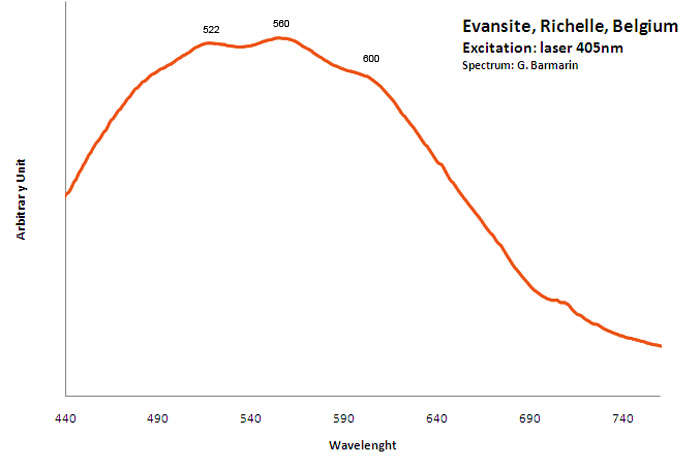Database of luminescent minerals
EVANSITE
Chemical formula: Al3(PO4)(OH)6 6H2O (?)
Family: Phosphates, Arseniates, Vanadates
Status: IMA-GP
Crystal system : Amorphous
Display mineral: NON
Associated names (luminescent varieties, discredited names, synonyms, etc.): BOLIVARITE,
Luminescence:
Longwave UV (365nm) colors: |
Greenish white , Bluish White , Yellowish White , | ||
Midwave UV (320nm) colors: |
Greenish white , Bluish White , Yellowish White , | ||
Shortwave UV (254nm) colors: |
Yellowish Green , Bluish White , Greenish , Greenish white , | ||
Daylight picture

CALCITE (improperly labeled EVANSITE), Richelle, Visé, Province de Liège, Belgique;
Daylight
Col. G.Barmarin; Photo: G. Barmarin
Longwave (365nm) picture

CALCITE (improperly labeled EVANSITE), Richelle, Visé, Province de Liège, Belgique;
UVLW
Col. G.Barmarin; Photo: G. Barmarin
Shortwave (254nm) picture

CALCITE (improperly labeled EVANSITE), Richelle, Visé, Province de Liège, Belgique;
UVSW
Col. G.Barmarin; Photo: G. Barmarin
Do you have a photo of this mineral you would like to see in the gallery? Contact us!
Phosphorescence (in the common sense of the term) observable with the naked eye:
No data
Comments:
Rik Dillen and Axel Emmermann have shown (2021) that evansite samples from a deposit along a road in Richelle (Belgium) and presenting a globular crust facies on a schistose rock (see picture), sold for decades on Belgian mineral fairs with the label evansite, are in fact mainly made of calcite (see also Philippo, 2019). An analysis by Raman spectrometry on several points of a sample of this type in my collection unambiguously indicates the presence of calcium carbonate and not of evansite (aluminum phospate). The fluorescence is also quite similar to that of many calcites. In some amateur collections, other samples of Richelle's evansite on a completely different matrix (breccia) also appear to be fluorescent as mentionned by Van Tassel in his paper (1959, see bibliography), but their exact nature needs to be confirmed (green crandallite?). The morphology of the samples described by Van Tassel in the gray breccia of Argenteau (white to gray nodules not exceeding one millimeter but showing fuorescence in blue-white tints) still does not correspond to these samples. In the book 'Les minéraux de Belgique' (Fransolet et al., 1974) evansite is not on the list of minerals from the locality of Richelle, but that of Argenteau (Philippo, 2019). The fluorescence of real evansite samples from Belgium therefore remains to be studied.
Activator(s) and spectrum:
Activator(s): (UO2)2+ (ion Uranyle) en impureté, ST (Singlet-triplet)-Matière organique en impureté,
Peaks in the spectrum (nm):
Organic impurities: Broad band centered around 500-550nm (not related to evansite but calcite from Richelle)

Col. G. Barmarin; Spectre: G. Barmarin
Comments on spectrum and activators:
The spectrum shape of classic samples from Richelle combined with strong phosphorescence lets think that the fluorescence is due to organic impurities (but finally those samples seem to be only common calcite!); Green fluorescence is clearly due to uranium in impurities (see bibliography).
Best localities for fluorescence (*):
- Richelle, Visé, Liège Province, Belgium (yellowish-white SW+LW labeled as evansite but in fact most samples are mainly calcite without the presence of evansite);
- Argenteau, Visé, Liège Province, Belgium (yellowish-white SW+LW labeled as evansite but in fact most samples are mainly calcite without the presence of evansite);
- Železník (Vashegy), Sirk, Revúca Co., Banská Bystrica Region, Slovakia (ex Gomor, Hungary LT);
- Porto, Porto District, Portugal (green SW);
(*)The data are not exhaustive and are limited to a few remarkable localities for fluorescence
Bibliographic reference for luminescence:
- The Henkel Glossary of Fluorescent Minerals, Dr. Gerhard Henkel, Published by the FMS, 1989 ,
Reference for luminescence on the Internet:
- Van Tassel R, Autunite, apatite, delvauxite, évansite et fluellite de la région de Visé, Bulletin de la Société belge de Géologie, 68, 226-248 (1959)
- Photo in daylight of sample on breccia matrix from Richelle (Belgium) said to be fluorescent
- Determination of uranium content in hyalite, opals and other minerals with the aid of fluorescence analysis, H. Haberlandt and F. Hermegger, Sitzber. Akad. Wiss. Wien, 155, 339 (1947)
- Etude préliminaire de la zone d altération radioactive de la pegmatite de Kobokobo (Kivu), par L. V AN WAMBEKE, bulletin de la societe belge de geologie, 066-1957
- Philippo S. (2019), Minéralogie de la commune de Visé (Argenteau, Richelle et Visé), Province de Liège, Belgique, Ferrantia # 81 (Travaux scientifiques du Musée national d histoire naturelle de Luxembourg), p 40
Mineralogical reference on the Internet:
 http://www.mindat.org/show.php?name=Evansite
http://www.mindat.org/show.php?name=Evansite
 http://webmineral.com/data/Evansite.shtml
http://webmineral.com/data/Evansite.shtml
Internet Search:
 Image search on 'Google Images'
Image search on 'Google Images'
 Search for documents in all languages on Google
Search for documents in all languages on Google
A request providing no result means only that no such reference exists in the database, but it does not mean that what you are looking for does not exist, just not to our knowledge. If you think you have found an error or omission, please let us know via the contact page being sure to cite the source of information.
